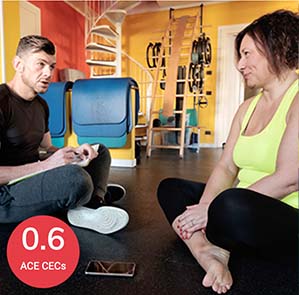
Everything in life (and in professional endeavors) seems to require juggling several responsibilities and wearing a variety of “hats.” As professionals in the health and exercise space, we teach our clients about balanced living and help them to develop strategies that allow them to harmonize the various aspects of their lives. One area where health and exercise professionals tend to get “stuck” is in trying to imagine how to balance health coaching with training their clients. If we had limitless time (and financial resources were not a concern for clients), we could hold an equal number of coaching and training sessions during the week.
While there is no single, magic formula for achieving an ideal balance between these two unique roles, there are models and perspectives that can be adapted to suit your personal needs and approach. Read on to explore a few approaches worth considering if you find it challenging to integrate coaching and training.
The Consumer Mindset Shift
As interest in the health and wellness industry continues to grow, consumers have a desire to focus on more than their physical health. As both a certified personal trainer and certified health coach, I witness this growing trend in the discovery calls I hold with new clients. The first question I ask: “What inspired you to book a call with me today?” In years past, clients would typically express their desire “to lose weight” or “tone up,” but those answers are not quite as common now. Instead, I hear responses such as, “I really want to feel better about myself,” or “I have had a very stressful year and I noticed that my energy levels have decreased and my stress levels have increased. I want to get that under control.”
Of course, clients will most likely always be interested in improving their health and fitness (as well as nutrition), but today’s client is also interested in prioritizing things like sleep, mindfulness and stress reduction. Creating innovative ways to combine health coaching with personal training produces a win-win for both you, the professional, and the clients you serve and hope to serve. Three highly skilled industry professionals share their perspectives and advice to help you identify the approaches that might work best for you in your practice.
Professional Perspective #1: Finding Harmony
For Lee Jordan, MS, NBC-HWC, ACE Master Coach and presenter, health coaching and training is not an either-or situation. His initial goal was to reduce client turnover and drive revenue, so he moved away from thinking about “balancing” health coaching and personal training services to “harmonizing” the relationship between them.
He encourages professionals to think about this analogy: “To balance something is to literally weigh this against that, and the items must weigh exactly the same, at the same time, or [it’s a] no go, you are out of balance. Harmony is blending different things together to serve a larger purpose—like an orchestra working in harmony to produce music.”
This approach focuses on offering a solution to clients versus selling a product or service. “What matters to the client is to achieve their wellness goals and to become the best most healthy and vibrant version of themselves,” explains Jordan. “[It doesn’t matter] if I am wearing my personal trainer hat or my health coaching hat.” For Jordan, this results in more income, more fulfilled clients and a more stable business model.
In practical terms, taking this approach might mean that for every 60-minute session scheduled, you engage the client in 40 minutes of personal training and 20 minutes of health coaching. How you choose to integrate the two will, of course, vary. You can begin the session with health coaching or bookend the personal training segment with 20 minutes of coaching. “In the long term, I earn more revenue and my client’s well-being is music to my ears,” says Jordan.
Professional Perspective #2: A Team-based Approach
Heidi Bodenheimer, NBC-HWC and practicing health coach, suggests a team-based approach that she’s seen work effectively in multiple settings. This approach applies to scenarios where a personal trainer is not also a health coach or vice versa.
If you are a certified personal trainer but have not yet earned a health coach certification (or vice versa), teaming up with a professional who possesses the experiences and credentials you lack can be both a viable and effective approach. Using a partnership or team approach offers three unique benefits:
1. The client enjoys the benefits of both specialties as they embark on their health and wellness journey.
2. Both professionals stay within their identified scopes of practice.
3. The variety of expertise that each professional offers provides an elevated training-coaching experience for the client.
Bodenheimer champions this approach because it provides the most “comprehensive plan for the client.” However, she acknowledges that the logistics of how such a collaborative partnership would work are “dependent on the needs of the client and their level of expertise with exercise, their goals, and their accountability needs.” Ideally, she says, “the health coach and personal trainer would work in tandem to develop the most effective strategy for the client.”
In practice, consider the following scenario:
A client seeks the services of a personal trainer because they have a desire to improve their physical health, energy levels and sleep habits. During the initial consult, the personal trainer learns that accountability and strategy are two barriers to success the client has experienced in the past. The client is interested in participating in three personal training sessions per week but would also benefit from two additional coaching sessions each month.
To effectively develop a plan of care that meets the client’s needs and respects the scope of practice, the personal trainer would meet with a qualified health coach they respect and feel comfortable referring a client to. During that conversation, the two professionals would discuss how they can collaborate to assist the client in achieving their goals. The personal trainer would develop a safe and effective goal-driven physical-activity program, while the health coach would help the client focus on habit development and change to address energy and sleep concerns. The two would engage in regular check-ins to monitor client progress, action plans and suggest necessary modifications to the plan of care.
Given the increase in virtual offerings, it is possible (and a great business strategy) to collaborate with professionals not located in your immediate geographic area, reminds Bodenheimer. This opens more doors and more opportunities to partner with professionals who have a wider range of expertise.
Professional Perspective #3: Thoughtful Integration – ACE Mover MethodTM as a Priority
Chris Gagliardi, ACE Scientific Education Content Manager, shares similar insights as Jordan, but offers an integrated approach so that personal training and coaching occur simultaneously instead of at separate times during sessions. What this might look like in practice depends on the frequency of sessions and a client’s specific needs and/or financial limitations.
To accomplish this integrative approach, Gagliardi encourages professionals to rely on the ACE Mover Method and utilize it during all sessions regardless of the purpose of any given session. “From my experience, health coaching skills can be used in all personal training sessions and not just during a distinct health coaching session,” explains Gagliardi. However, if, during a personal training session, a trainer uncovers information that suggests that more than the ACE Mover Method is needed, a dedicated health coaching session should be scheduled.
This deserves a bit more explanation. When you begin working with a new client, you collect a lot of information from your initial interview and the client’s health history. This information, combined with your intuition and expertise as a health coach, helps you to not only discern what a client hopes to achieve by working with you as a personal trainer but also what behaviors they hope to change outside of the time spent with you during exercise sessions. Once a behavior-change focus has been agreed upon, the underlying why has been discovered, initial goals or actionable next steps have been agreed upon, and preferred methods of accountability have been discussed, you can integrate your follow-up coaching sessions with your exercise training sessions. This might look like checking in with current goals at the beginning of the exercise session and discussing how your client was able to be successful. Or you might discuss any barriers to success that were encountered and then follow up with setting or reaffirming goals during the cool-down portion of the exercise session. If, however, your client does not already have a clear focus and self-discovery activities are needed, or if it becomes clear that a client would benefit from more information on a specific topic, it may be worth considering moving from an in-the-moment blended approach to an approach that focuses on personal training apart from coaching.
Essentially, it is helpful to recall that coaching is like a dance. If coaching skills can be blended within a personal training session while keeping the rhythm and flow of both intact, it can be a useful strategy. If the dance becomes clumsy and out of sync, however, a clear separation of skills may be the best approach.
Gagliardi also suggests integrating the ACE Mover Method elements of coaching into the warm-up and cool-down segments of a personal training session. “This time could be used to check on how the client is doing with working toward their goals and to set or reaffirm goals. If goals, or the level of importance or urgency of goals, changes this would also be a good time to schedule a dedicated health coaching session.”
A common question that comes up for professionals is how to schedule coaching sessions. “If you are a professional who is certified to serve in both capacities, when coaching sessions are scheduled depends on the timing of exercise sessions and should be a collaborative discussion between the coach and client,” says Gagliardi. Consider this example: “If a client wants to exercise three days per week and feels like they will lose motivation by the end of the week and seem to talk themselves out of their Saturday workout, it may be a good idea to schedule a health coaching session for Friday afternoon or evening so that you can help uncover the clients why and evoke change talk.” Additionally, the frequency of health coaching sessions might depend on how successfully the client is adhering to their goals, or if their goals are unrelated to physical fitness.
Another variable to consider when determining the frequency and types of sessions for a given client is the other services you offer, such as group coaching, emails, texts and video chats. Much like Jordan’s “harmony-focused” approach, Gagliardi feels that “ultimately, the rhythm of health coaching to personal training should be up to the client and professional to find a groove that works best.”
How might this look with a new client? Gagliardi offers a sample structure:
Initial Session Structure for a New Client
- The first meeting is an initial health coaching session that focuses on identifying the client’s health history, establishing rapport, and setting the stage and goals or next steps. If the client reveals a focus that is exercise-related, schedule an initial personal training session.
- The next meeting is an initial personal training session and the frequency of sessions per week is determined.
- Schedule one coaching session per week (initially) and eventually move to biweekly health coaching sessions. Be open to scheduling additional sessions, if needed.
- Move to monthly formal coaching sessions or transition to group coaching (if available) if the client thinks it would be valuable.
Putting it Into Practice
Is it necessary to be certified in both areas to guide clients toward success? Ideally, but not necessarily. Many professionals (including the three interviewed here) achieve great success with their clients either by partnering with another professional or having obtained both credentials. It’s possible to go different directions and you must decide what works best for you and the clients you hope to serve.
As a practicing personal trainer and health coach, I use a variety of approaches based on the client with whom I’m working. For example, if I have a client who expresses an exercise-based goal, but has challenges with motivation, I integrate coaching into the sessions, much like Jordan and Gagliardi advise. However, I also have clients who possess unique needs or who are dealing with a chronic condition with which I am less experienced, so I partner with another health coach who has that type of knowledge and experience. It’s still a win-win.
A professional who possesses both credentials, notes Gagliardi, offers a unique benefit to their clients. “If you are working with clients in both capacities, you can offer in-person real-time accountability. For example, if your client has set a goal with you as the health coach to complete three personal training sessions per week and you are also their personal trainer, this adds an additional layer of accountability and an ability to track client progress consistently.”
Striking the right balance is about creating a harmonized tempo that meets the multiple needs—and that might not be the same for every client. “I think the key is to find the right balance of interaction that best supports clients on their journey,” explains Gagliardi. “I also think that health coaching is not something that is easily turned off and on. As a health and exercise professional, it is essential that you learn to recognize when your client needs to focus on training and when they need the benefits of health coaching.” Ultimately, this will be the key to success for both you and your clients.
Expand Your Knowledge
 |
Designed for health coaches, exercise professionals and healthcare professionals, this interactive course provides the core coaching competencies and communication techniques you need to practice and refine your behavior change coaching skills for the most effective results.
|
 |
This video training explores the individual and combined effects of physical activity and nutrition interventions provided by exercise professionals. You’ll gain knowledge of how to leverage multidisciplinary approaches that establish positive behavior changes in adults and learn how evidence from exercise and nutrition practitioner guidelines align with the ACE Integrated Fitness Training® (ACE IFT®) Model, along the health, fitness and performance spectrums.
|
 |
Whether you are coaching clients in chronic pain or stress management, this course bundle has you covered. Learn the latest techniques and strategies to work more effectively with your clients so they can establish healthy habits that last a lifetime.
|





 by
by 





